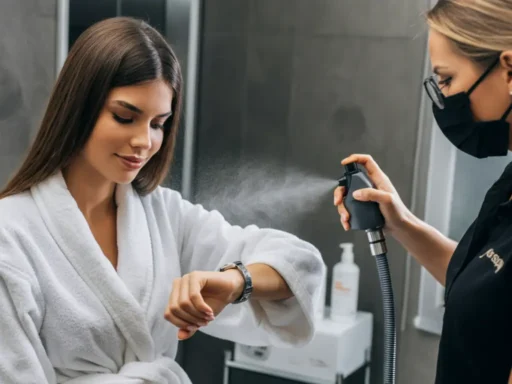If you love the sun-kissed glow of a spray tan but worry about moles, freckles, or sunspots darkening more than the rest of your skin, you’re not alone. This common issue stems from how DHA, the active ingredient in spray tans, interacts with pigmented areas of the skin. The good news? It’s totally avoidable with the right preparation and care.
This guide will teach you everything you need to know about how to not darken moles when spray tanning. From understanding why moles darken to expert application tips and post-tan care, you’ll learn how to achieve a flawless, even tan every time.
- Why Do Moles Darken More After a Spray Tan
- Is It Safe to Spray Tan Over Moles
- Tips to Prevent Spray Tan from Sticking to Moles and Dark Spots
- What to Apply on Moles Before a Spray Tan
- Post-Tan Care to Keep Your Skin Even
- Should You Cover Moles Before a Spray Tan
- Real User Concerns Answered
- When to Be Concerned About Changing Moles
- Checklist for Spray Tan Prep and Aftercare
- Conclusion
Why Do Moles Darken More After a Spray Tan
Ever noticed your moles or dark spots seem to absorb more color during a spray tan? That comes down to skin composition and how DHA interacts with pigmentation.
Melanin Concentration
Moles, freckles, and sunspots have higher levels of melanin, which naturally makes them darker than the surrounding skin. During a spray tan, the DHA reacts more intensely with these areas, causing them to darken further.
Thicker Skin Cells
These pigmented areas often have a slightly thicker skin cell composition, enabling DHA to bind more effectively, which results in the exaggerated darkening of moles and spots.
DHA’s Targeted Reaction
DHA, the sugar compound responsible for creating a tan, chemically reacts with the top layers of skin. On pigmented or dense spots, this reaction occurs more profoundly, resulting in darker development. Although this darkening is purely cosmetic and temporary, it can disrupt the even appearance of your tan.
Worried this is happening because of a mistake you’re making? Don’t be. It’s a common concern, even voiced frequently in beauty forums like Reddit or by pros at places like Austin360Tans.
Is It Safe to Spray Tan Over Moles
Spray tanning over moles often sparks concerns about safety. It’s important to separate fact from fiction.
Spray Tans Are Cosmetic, Not Harmful
Spray tans work on the outermost layer of your skin and do not penetrate deeper layers. The darkening of moles, freckles, or sunspots is a purely cosmetic effect and does not harm your skin or moles.
No Evidence of Skin Cancer Risk
There is no scientific evidence linking DHA in spray tans to skin cancer. The darkening of moles is merely surface-level, but as a precautionary measure, be sure to monitor moles for any changes unrelated to tanning.
Dermatologist Advice Is Always Valuable
If you’re unsure about changes in your skin or have a history of skin concerns, consult a dermatologist before spray tanning. Knowing when to address a potential medical concern is key for overall skin health.
Tips to Prevent Spray Tan from Sticking to Moles and Dark Spots
Learning how to not darken moles when spray tanning starts with a few easy steps. Here’s how you can prepare:
Apply a Barrier Cream
Use a spray tan barrier for dark spots, such as petroleum jelly or specific barrier creams, to create a thin protective layer over moles, freckles, or sunspots. This prevents DHA from fully reacting with these areas.
Light Dabbing Technique
Before heading into a spray tanning session, lightly dab a small amount of barrier product onto the moles. Use a Q-tip to avoid over-application.
Expert-Approved Advice
Many professional spray tan technicians recommend blending the edges of the barrier cream to avoid noticeable outlines. You can find video demonstrations of this on YouTube for step-by-step guidance.
What to Apply on Moles Before a Spray Tan
Choosing the correct products for mole protection can make all the difference when achieving an even tan.
Safe Ingredients
Opt for lightweight, non-comedogenic creams that won’t clog pores. Aloe-based gels or water-based formulas work well as barriers because they’re gentle yet effective.
Avoid These Products
Stay away from sticky lotions, heavy oils, or body butters. These can trap DHA unevenly and cause blotchy discoloration.
Recommended Barrier Products
Use products specifically designed for spray tan prep whenever possible. These are often formulated for easy application and removal.
Post-Tan Care to Keep Your Skin Even
Even if you’ve prepared diligently, some slight darkening of moles or spots may happen. Here’s how to address it:
Use Micellar Water
Dip a Q-tip in micellar water to gently lighten any over-darkened spots immediately after tanning. This helps reduce contrast without affecting the rest of your tan.
Moisturize Regularly
Dry skin can lead to uneven fading, so keep your skin hydrated. Use a lightweight moisturizer daily to maintain a smooth and even tan.
Go Easy on Exfoliation
If you notice buildup around moles after a few days, gently exfoliate with a non-abrasive product to remove excess tan without stripping your skin.
Should You Cover Moles Before a Spray Tan
Whether or not to cover moles is a personal choice. Here are a few options:
Use Makeup Caps or Stickers
Mole stickers or makeup caps are a DIY mole protector, covering the moles in an absolutely abandoned manner in comparison with the DHA exposure obtained during the tanning process.
Rely on Barrier Creams
If you prefer not to use stickers, applying a light layer of barrier cream is usually sufficient to protect moles while preserving the tan’s natural look.
Expert Recommendations
Many professional spray tan artists suggest leaving moles exposed unless you have numerous spots in one area. Using breathable products is a great alternative to covering moles completely.
Real User Concerns Answered
Below are answers to a few common questions spray tan users often ask online:
1
Can spray tans make moles look darker?
Yes, but applying a barrier cream can help minimize this.
2
What should I put on moles before tanning?
Use petroleum jelly or non-comedogenic creams as a protective layer.
3
Is it OK to cover moles with Vaseline?
Yes, Vaseline is highly effective as a barrier for moles during spray tanning.
4
Do moles absorb more spray tan?
They do, due to their higher melanin content and unique skin cell composition.
When to Be Concerned About Changing Moles
While cosmetic darkening from spray tans is harmless, always monitor your moles for significant changes that could indicate a medical concern.
Pay Attention to Changes
Look for size increases, irregular shapes, or uneven coloring in moles. These could indicate something beyond cosmetic darkening.
Schedule Regular Skin Checks
Routine dermatologist visits are an excellent way to ensure your skin stays healthy, especially if you have many moles or a family history of skin conditions.
Checklist for Spray Tan Prep and Aftercare
Before your next spray tan, run through this quick checklist for Spray Tan Prep and Aftercare:
Exfoliate your skin thoroughly.
Apply a barrier cream on moles, freckles, and sunspots.
Wear loose-fitting clothing to your session.
Moisturize daily to maintain an even fade.
Use micellar water and Q-tips for touch-ups.
Conclusion
Learning to avoid darkening of moles during spray tanning helps you not miss out on a fantastic glow with smooth and beautiful effects. A professional-looking tan can be easily attained provided one makes the correct preparations, equipment and precautions. If you’re still uncertain or want personalized advice, consult a professional spray tan technician or dermatologist.
Here’s to glowing confidently and evenly, every time!






